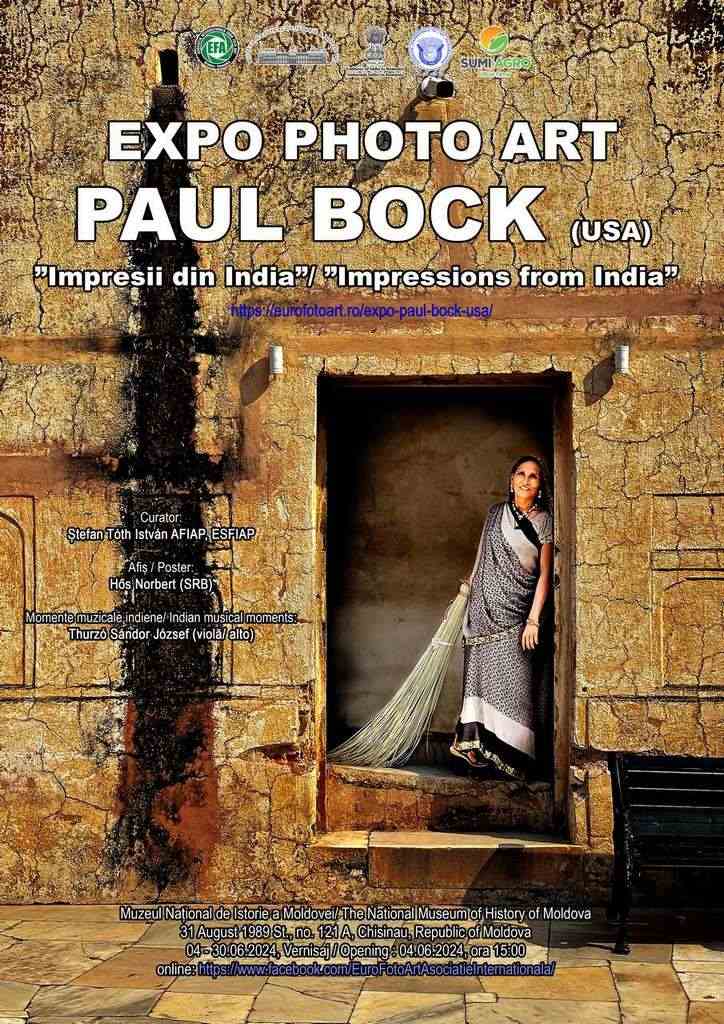 The International Association "Euro Photo Art" from Oradea (AIEFA) has prepared for photography lovers from the Republic of Moldova, an exhibition of photographic art of great artistic value, entitled "Impressions from India", which was also opened last year at the Palace of the Parliament in Romania, on the occasion of the 75th anniversary of diplomatic relations between Romania and India.
The International Association "Euro Photo Art" from Oradea (AIEFA) has prepared for photography lovers from the Republic of Moldova, an exhibition of photographic art of great artistic value, entitled "Impressions from India", which was also opened last year at the Palace of the Parliament in Romania, on the occasion of the 75th anniversary of diplomatic relations between Romania and India.
The exhibition is organized under the auspices of the International Federation of Photographic Art recognized by UNESCO, in partnership with the National History Museum of Moldova, the Embassy of India in Romania and the Republic of Moldova respectively Summit Agro Romania, a company belonging to the Japanese corporation Sumitomo, supporter of agriculture and art.
This time, a selection of 50 large-format photographs will be installed on the easels in the hall at the entrance to the National History Museum of Moldova, made by the renowned photographer artist Paul Bock from the United States of America, originally from Oradea, member of AIEFA. The images were taken during a creative trip of the renowned photographic artist in the summer of 2022 in India. The images can also be viewed on the website of the International Association: https://eurofotoart.ro/expo-paul-bock-usa/.
The opening of the photographic art exhibition entitled "Impressions from India" will take place on Tuesday 04 June 2024, at 15:00, in the entrance hall of the National History Museum of Moldova, in the presence of distinguished guests, including the Ambassador of India in Romania, the Republic of Moldova and Albania, His Excellency Rahul Shrivastava, curator of the exhibition, photographer artist Ștefan Tóth István, President of AFIAP, ESFIAP and Dr. Eng. Patricia Maria Ştirbu, President of Summit Agro for Romania, the Republic of Moldova, Bulgaria and Adria.
On this occasion, the photographic art album "Impressions from India", by the photographer Paul Bock, published with the financial support of the Embassy of India in Romania and under the care of the publishing house "Euro Foto Art", will be released.
The musical moments of the opening will be provided by the renowned Oradean viola artist Thurzó Sándor József, who will perform several pieces from the Indian repertoire: "Poor Heart" by A.R. Rahman¸ "Fire in the city of Poroshmoni" by R. Tagore, "I still want you" by Mithoon and "Sare Jahan Se Acha" by Suhale Mazoor. The opening will be broadcast online on the Association's facebook address: https://www.facebook.com/EuroFotoArtAssociation
The famous photographer Paul Bock was born in Oradea, he graduated from the Mixed Classical High School in his hometown, and after obtaining an engineering degree from the Polythenic Institute of Timisoara, he returned to Oradea for a period of time, then, for 26 years, led a petrochemical plant design workshop in the USA, South Korea, Venezuela, Argentina, Brazil, Israel and Italy. His dream from his youth - photography - was forgotten, because of the activities of this period. After the family situation allowed him to do so, he also devoted himself to photography. Thus, from the year 2000, he studied with the renowned artist photographer Larry Jeans, the assistant in his youth to the renowned world-class photographer Ansel Adams. In 2004 he obtained the Diploma Tri - Community School of Photography from Los Angeles. On August 4, 2013, he joined the "Euro Photo Art" Association, and from 2017 he became the vice-president of the International Association for the USA. He regularly participated with his works in various international projects organized by the "Euro Photo Art" Association in different parts of the world.
Throughout his artistic career he obtained a series of international awards and distinctions. From his works, two exhibitions of photographic art were opened in 2009 and 2018, in the longest-running permanent gallery of photographic art in Romania, the "Euro Foto Art" Gallery - Oradea (RO), which in 2019 also became the 17th FIAP Exhibition Center in the world.

















































